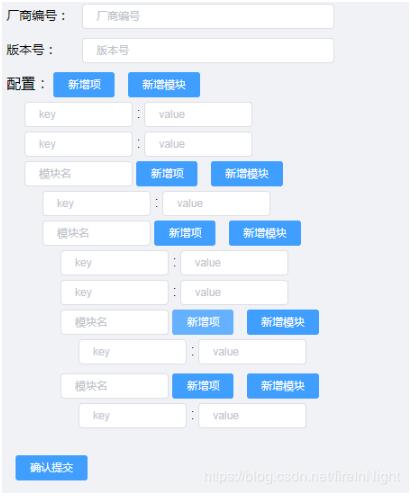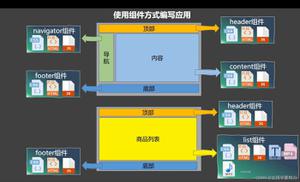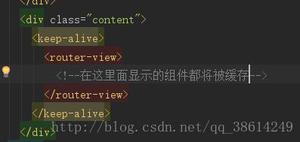解决vue单页面多个组件嵌套监听浏览器窗口变化问题
需求
最近公司有个大屏展示项目(如下图)

页面的元素需要做响应式监听,图表需要跟着窗口响应变化
问题
每一个图表都被我写成了一个组件,然后就在每一个组件里写了一串代码,监听浏览器变化
结果只有父组件的代码生效
mounted(){
window.onresize = () => { //当窗口发生改变时触发
//
};
}
原因
经简单测试后发现,同一个路由页面只能注册一次浏览器窗口监听事件,第二次注册的会覆盖第一次注册
下边代码即可测试
mounted(){
window.onresize = () => { //当窗口发生改变时触发
console.log(1)
};
window.onresize = () => { //当窗口发生改变时触发 (会覆盖上一个函数)
console.log(2)
};
}
父子嵌套组件同理,子组件生命周期执行在父组件之前,父组件函数会覆盖子组件函数
解决方案
1、只在父页面写个监听,但是通过组件传值的方式传给子组件,并且子组件用watch监听传值的变化,响应改变
2、假如是多层组件嵌套,用vuex可能会更省力
补充知识:vue/组件嵌套/无限嵌套/嵌套组件消息传递/嵌套父子组件传值
目前接到一个需求,是我之前从来没有实践过的,正好趁此机会做一个深度剖析,并记录下这次的成长,并分享给大家。
需求文档
一 、(一个厂商编号和一个版本号)唯一决定一个配置
二 、 配置内容支持无限嵌套
三、配置数据格式示例(配置包括项和模块):
{
"vendorId": "IL03#sub_01",
"version": "9.0.0",
"config": {
"module-1": {
"property-1": "value-1",
"property-2": "value-2",
"property-3": "value-3",
"module-1_1": {
"property-1_1": "value-1_1",
"property-1_2": "value-1_2",
"property-1_3": "value-1_3"
}
},
"module-2": {
"property-4": "value-4",
"property-5": "value-5"
}
}
}
四、配置成果物如下:

需求分解
一个简单的嵌套组件:
<template>
<div>
<span>{{data.content}}<span>
<div>
<nested :data="data.child"></nested>
<div>
</div>
</template>
<script>
export default {
name: 'nested',
props: ['data']
}
</script>
我们给最外层的组件(根嵌套组件)绑定形如
{
"content": "value",
"child": {
"content": "value-1"
"child": {
"content": "value-1_1"
......
}
}
}
的数据结构,就可以看见效果了,是不是和我们前面需求的数据结构很像?
开始动工
step1:最外层列表展示
这里作为静态路由页面展示即可(分页、查询、删除功能在这里做)
<!-- 这里使用了EL-UI -->
<template>
<!-- 应用配置入口 -->
<div class="app-config-wrap">
<!-- 增 -->
<div class="app-config-add">
<el-button type="primary" size="mini" @click="handleClickAdd">新增配置</el-button>
</div>
<!-- 查 -->
<div class="app-config-search">
<div class="label" @click="isShowFilter = !isShowFilter">
<span class="text">查询App配置</span>
<span class="el-icon-caret-right" v-if="!isShowFilter"></span>
<span class="el-icon-caret-bottom" v-else></span>
</div>
<div class="clear-all" @click="handleClearAll" v-if="isShowFilter" title="点击清空所有查询条件">
<span class="text">清空条件</span>
</div>
<div class="form-wrap" v-show="isShowFilter">
<div class="by-vendorId">
<el-input type="text" size="mini" placeholder="按厂商编号查询" clearable v-model.trim="vendorId">
</el-input>
</div>
<div class="by-version">
<el-input type="text" size="mini" placeholder="按版本号查询" clearable v-model.trim="version">
</el-input>
</div>
<div class="search-button">
<el-button type="primary" size="mini" @click="handleClickSearch">查 询</el-button>
</div>
</div>
</div>
<div class="app-config-main" :style="tableHeight">
<el-table size="mini" height="100%" :data="configList" stripe @row-click="handleClickRow"
highlight-current-row style="width: 100%;">
<el-table-column type="index" label="No." width="60"></el-table-column>
<el-table-column prop="vendorId" label="厂商编号" :show-overflow-tooltip="true"></el-table-column>
<el-table-column prop="version" label="版本号" :show-overflow-tooltip="true"></el-table-column>
<el-table-column prop="operation" label="操作">
<template slot-scope="scope">
<!-- 删 -->
<el-button type="danger" size="mini" @click="handleClickDelete(scope.row.id)">删除配置</el-button>
</template>
</el-table-column>
</el-table>
</div>
<el-pagination class="pagination" v-if="total" background small :current-page="pageNum"
:page-sizes="[10, 20, 40, 60]" :page-size="pageSize" layout="total, sizes, prev, pager, next, jumper"
:total="parseInt(total)" @current-change="changePageNo" @size-change="changePageSize">
</el-pagination>
</div>
</template>
<script>
export default {
name: 'appConfig',
components: {},
props: [],
data () {
return {
isShowFilter: false,
vendorId: '',
version: '',
pageNum: 1,
pageSize: 20,
total: 0,
configList: [{ // 假数据
id: 1,
vendorId: 'cjm',
version: '10.0.0'
}]
}
},
computed: {
tableHeight () {
return this.isShowFilter ? { height: 'calc(100% - 129px)' } : { height: 'calc(100% - 90px)' }
}
},
methods: {
handleClearAll () {
this.vendorId = ''
this.version = ''
},
handleClickSearch () { // 这里发送查询请求
},
changePageNo (val) { // 这里发送分页请求
this.pageNum = val
},
changePageSize (val) { // 这里发送分页请求
this.pageSize = val
},
handleClickDelete (id) { // 这里发送删除请求
},
handleClickAdd () { // 使用路由方式跳转到配置页面(增加配置和修改配置同一页面即可)
this.$router.push({
name: 'configData',
query: {}
})
},
handleClickRow (row) { // 通过id让配置页面初始化时请求数据,在跳转页面中watch即可
this.$router.push({
name: 'configData',
query: {
id: row.id
}
})
}
}
}
</script>
// 样式我就不贴了,节省篇幅
step2:动态路由页准备
由于配置页面展示是根据厂商编号和版本号动态改变的,所以这里用到
this.$router.push({
name: 'configData',
query: {
id: row.id
}
})
来实现动态路由页面,这里也需要引入我们的根嵌套组件(嵌套入口)。
<template>
<div class="config-data-warp">
<div class="config-head">
<span class="text">厂商编号:</span>
<el-input class="config-input" type="text" size="mini" placeholder="厂商编号"
clearable v-model.trim="vendorId">
</el-input>
</div>
<div class="config-head">
<span class="text">版本号:</span>
<el-input class="config-input" type="text" size="mini" placeholder="版本号"
clearable v-model.trim="version">
</el-input>
</div>
<div class="config-main">
<config-module :data="config" :root="true"
:commit="commit" @commit="handlerCommit"></config-module>
</div>
<el-button class="config-commit-btn" type="primary"
size="mini" @click="commit = true">确认提交</el-button>
</div>
</template>
<script>
import configModule from './configModule'
export default {
name: 'configData',
components: {configModule},
data () {
return {
id: this.$route.id,
commit: false,
vendorId: '',
version: '',
config: {} // 这里放点假数据
}
},
mounted () { // 如果id存在,就去请求数据
if (id) { ... }
},
methods: {
handlerCommit (data) { // 这里是汇总数据的地方,记下来,等下提到了好找
console.log(data)
this.commit = false
}
}
}
</script>
值得注意的是,确认提交按钮只是将commit变量置为true,而commit绑定在我们的嵌套组件中。
<div class="config-children" v-for="(value, index) in configJsonChildren" :key="index + 'child' + moduleName">
<config-module :index="index" @change="changeChildName" @commit="handlerCommit"
:commit="commit" :data="{key: value[0], child: value[1]}"></config-module>
</div>
这是嵌套组件的部分代码,我们可以看到commit被原封不动的传递给了子嵌套组件,也就是说,这里的commit变量起到通知所有嵌套组件执行了提交动作,这也是父组件控制子组件组件的唯一方式——传递数据变化props(或者使用vuex也可以)。
这里还有一点,就是定义什么是嵌套部分,什么是嵌套外部分,显然,厂商编号和版本号不属于嵌套部分。
还有传入的root变量,是为了控制根嵌套组件的名称不可修改,所以传个true就可以了。
step3:嵌套组件的实现(重点)
这里梳理一下嵌套组件需要提供的功能点:
1、能够做到传入数据的展示
2、能够动态添加项和模块
3,能够将修改了的数据传递出去
传入数据的展示
我们再回过头看看后台传给我们的数据格式:
{
"vendorId": "IL03#sub_01",
"version": "9.0.0",
"config": {
"module-1": {
"property-1": "value-1",
"property-2": "value-2",
"property-3": "value-3",
"module-1_1": {
"property-1_1": "value-1_1",
"property-1_2": "value-1_2",
"property-1_3": "value-1_3"
}
},
"module-2": {
"property-4": "value-4",
"property-5": "value-5"
}
}
}
从中我们是否可以提炼出每个嵌套组件的数据格式?
module: {
property-1: value-1,
property-2: value-2,
......
module-1: { ...... },
mpdule-2: { ...... },
......
}
而且,我们需要这个对象的key和value是可以被双向绑定的。
可是我们想一下,对象的key可以双向绑定吗?显然不能!
这也就是说,原始传入的数据结构并不能用,需要进行处理:
<template>
<div class="config-module-warp">
<div class="config-head">
<!-- 根组件固定模块名,或者说不需要模块名 -->
<span class="config-header-item" v-if="root">配置:</span>
<div class="config-header-item" v-else>
<el-input class="config-module-name" type="text" size="mini"
placeholder="模块名" clearable v-model="moduleName" @change="changeModuleName"></el-input>
</div>
<el-button class="config-header-item" type="primary" size="mini"
@click="handleClickAddProperty">新增项</el-button>
<el-button class="config-header-item" type="primary" size="mini"
@click="handleClickAddModule">新增模块</el-button>
<el-button v-if="root" class="config-btn" type="danger" size="mini"
@click="handleClickClear">清空配置</el-button>
<el-button v-else class="config-btn" type="danger" size="mini"
@click="handleClickDeleteModule">删除模块</el-button>
<div class="config-property" v-for="(value, index) in configJsonProperty"
:key="index + 'property'">
<el-input class="config-property-value" type="text" size="mini"
placeholder="key" clearable v-model="value[0]"></el-input> :
<el-input class="config-property-value" type="text" size="mini"
placeholder="value" clearable v-model="value[1]"></el-input>
<el-button class="config-header-item" type="danger" size="mini"
@click="handleClickDeleteProperty(index)">删除该项</el-button>
</div>
<div class="config-children" v-for="(value, index) in configJsonChildren"
:key="index + 'child'">
<config-module :index="index" @change="changeChildName" @commit="handlerCommit"
:commit="commit" :data="{key: value[0], child: value[1]}"></config-module>
</div>
</div>
</template>
...
data () {
return {
moduleName: '', // 绑定当前子模块名
configJsonProperty: [], // 这里是子模块的property
configJsonChildren: [], // 这里是子模块下的子模块(孖模块^-^)
...
}
}
...
mounted () {
if (this.data && this.root) {
// 由于根节点是没有模块名的,数据的解析结构是{key: moduleName, child: moduleValue},参上。
this.classify({child: this.data})
} else if (this.data) {
this.classify(this.data)
}
}
// 或者将引用根组件的地方改成下面这样也可以:
// <config-module :data="{child: config}" :root="true" :commit="commit"
// @commit="handlerCommit"></config-module>
// _____________________________________
// mounted () {
// if (this.data) {
// this.classify(this.data)
// }
// }
...
classify (prop) {
let data = prop.child
this.moduleName = prop.key
for (let key in data) {
if (typeof data[key] === 'object') {
this.configJsonChildren.push([ // 这里将数组转化为可以双向绑定的二维数组
key,
data[key]
])
} else {
this.configJsonProperty.push([
key,
data[key]
])
}
}
}
实现动态增加
只需要添加空项就行了,但由于模块是由父组件传入的,所以改变模块名也需要同步改变父组件的模块名,而这里就用到了props中的index,代表父组件中的位置。
handleClickAddProperty () {
this.configJsonProperty.push([
'',
''
])
},
handleClickAddModule () {
this.configJsonChildren.push([
'',
{}
])
},
changeModuleName (value) {
this.$emit('change', this.index, value)
},
changeChildName (index, name) {
this.$set(this.configJsonChildren[index], 0, name)
},
孪生兄弟:动态删除
其实,增加数据和删除数据无外乎就是,本地数据本地改,外部数据同步改:
handleClickClear () {
// 如果本身就是空,就无需操作,防止误操作,毕竟我挺讨厌弹窗的
if (!this.configJsonProperty.length && !this.configJsonChildren.length) {
return
}
// 敏感操作给个弹窗
this.$confirm('确定清空所有配置?', '警告', {
confirmButtonText: '确定',
cancelButtonText: '取消',
type: 'warning'
}).then(() => {
// 这个是本地触发的哦!
this.configJsonProperty = []
this.configJsonChildren = []
})
},
handleClickDeleteProperty (index) { // 本地数据本地改
this.configJsonProperty.splice(index, 1)
},
handleClickDeleteModule () {
// 外部数据传出改,由于是删除操作,外部销毁了会直接导致本地销毁,本地无需再销毁
// 和改模块名不一样
// 改模块名时,虽然外部数据改变触发了本地更新,但由于是push操作,并不会改变本地数据
this.$emit('delete', this.index)
},
deleteModule (index) {
// 与handleClickDeleteProperty方法比较,一定要分清哪个是子组件触发,哪个是父组件触发
this.configJsonChildren.splice(index, 1)
},
重中之重:提取这个树结构中的数据
数据在各个子组件中保存,怎么把它们提取出来呢?
聪明的你肯定马上想到了我之前所说的commit变量吧,它将这个动作分发到了各个子组件。
所以,只要每个子组件听从命令,把数据层层上报,是不是就完成了呢?
这就好比是公司总经理想要开发一个软件,他就只要告诉各个部门:
哎,你们软件部负责做出软件可行性方案;
你们市场部负责调查同类软件和市场份额;
你们营销部赶快出炉软件推广方案,等等。
然后部门总监给各项目经理发小人物,然后项目经理再分解任务成需求给你。
最后做完了,流程就是:你 -》经理-》总监-》总经理。
在我们这份代码中,也是这样子的:
第一步:你要知道任务来了:
watch: {
commit (val) {
if (val) {
this.handleClickCommit() // 接到任务
} else {
this.commitData = {} // 这里也标记一下
}
}
},
第一步:找到最底层的“你”,也就是找到这个树组件的末梢节点,
它的标志是:
if (!this.configJsonChildren.length) { ...... } // 他没有子节点了
d收集它的“工作成果”:
let obj = {}
this.configJsonProperty.forEach(v => {
if (v[0] && v[1]) {
obj[v[0]] = v[1]
} else {
this.$emit('error') // 如果有项不完整,可以报错
}
})
你觉得上面代码有没有小问题?给你五秒想一想。
1
2
3
4
5
有没有这样一种情况?我们一不注意写了两个同样键名的项,不管是写到了错的模块里面还是怎样。
那么在上面的代码中,就会使得新值覆盖旧值,就有可能导致严重的事故!!!
所以我们改成:
handleClickCommit () {
if (!this.configJsonChildren.length) {
if (!this.moduleName && !this.root) {
this.$emit('error')
return
}
let obj = {}
for (let v of this.configJsonProperty) {
if (v[0] && v[1]) {
if (obj.hasOwnProperty(v[0])) {
this.$emit('error') // 啊,一不小心走神了
return
}
obj[v[0]] = v[1]
} else {
this.$emit('error')
// 这里不需要return是因为不会造成严重后果,当然也可以加上
// 主要是我用这个功能时会一口气添加好多项,也不一定全填满,省得一个个删。
}
}
this.$emit('commit', { // 把数据给经理!!!这个杀千刀的,天天催!
key: this.moduleName, // 身份狗牌
value: obj
})
}
}
啊,工作终于提交了,再也不担心了,接下来的事就交给经理去做吧!
经理:我手下管着这么多人,不可能来一个我上交一个吧?那就等他们全部上交了,我再整个打包上交吧。
首先第一步,我需要一个箱子来存他们的成果:
data () {
return {
moduleName: '',
configJsonProperty: [],
configJsonChildren: [],
commitData: {} // 存放成果的箱子
}
}
接下来就等他们上交了:
handlerCommit (data) {
if (!this.moduleName && !this.root) { // 领导也要有名字,但总经理只有一个
this.$emit('error')
return
}
this.commitData[data.key] = data.value // 先按人头收下成果
for (let item of this.configJsonChildren) {
if (!this.commitData.hasOwnProperty(item[0])) return // 如果没收齐,继续等待
}
// 欧耶,收齐了
let obj = {}
for (let v of this.configJsonProperty) { // 这个for循环可以封成一个函数的,毕竟写了两次
if (v[0] && v[1]) {
if (obj.hasOwnProperty(v[0])) {
this.$emit('error')
return
}
obj[v[0]] = v[1]
} else {
this.$emit('error')
}
}
this.$emit('commit', {
key: this.moduleName,
value: Object.assign(obj, this.commitData) // 领导自己的成果加上员工的成果
})
}
还记得上面我让你记下的地方吗?
handlerCommit (data) {
console.log(data) // 汇总数据,在这里可以发送给后台了
this.commit = false // 任务完成标志
}
watch: {
commit (val) {
if (val) {
this.handleClickCommit()
} else {
this.commitData = {} // 初始化子组件
}
}
},
到这里,嵌套组件也大致完工了,贴全代码:
<template>
<div class="config-module-warp">
<div class="config-head">
<span class="config-btn" v-if="root">配置:</span>
<div class="config-btn" v-else>
<el-input class="config-module-name" type="text" size="mini" placeholder="模块名"
clearable v-model="moduleName" @change="changeModuleName"></el-input>
</div>
<el-button class="config-btn" type="primary" size="mini"
@click="handleClickAddProperty">新增项</el-button>
<el-button class="config-btn" type="primary" size="mini"
@click="handleClickAddModule">新增模块</el-button>
<el-button v-if="root" class="config-btn" type="danger" size="mini"
@click="handleClickClear">清空配置</el-button>
<el-button v-else class="config-btn" type="danger" size="mini"
@click="handleClickDeleteModule">删除模块</el-button>
</div>
<div class="config-property" v-for="(value, index) in configJsonProperty" :key="index + 'property'">
<el-input class="config-property-value" type="text" size="mini"
placeholder="key" clearable v-model="value[0]"></el-input> :
<el-input class="config-property-value" type="text" size="mini"
placeholder="value" clearable v-model="value[1]"></el-input>
<el-button class="config-btn" type="danger" size="mini"
@click="handleClickDeleteProperty(index)">删除该项</el-button>
</div>
<div class="config-children" v-for="(value, index) in configJsonChildren" :key="index + 'child'">
<config-module :index="index" @change="changeChildName" @delete="deleteModule"
@commit="handlerCommit" :commit="commit" :data="{key: value[0], child: value[1]}"></config-module>
</div>
</div>
</template>
<script>
export default {
name: 'configModule',
props: ['data', 'root', 'commit', 'index'],
data () {
return {
moduleName: '',
configJsonProperty: [],
configJsonChildren: [],
commitData: {},
error: false
}
},
watch: {
commit (val) {
if (val) {
this.handleClickCommit()
} else {
this.commitData = {}
this.error = false
}
}
},
computed: {
},
mounted () {
if (this.data) {
this.classify(this.data)
}
},
methods: {
classify (prop) {
let data = prop.child
this.moduleName = prop.key
for (let key in data) {
if (typeof data[key] === 'object') {
this.configJsonChildren.push([
key,
data[key]
])
} else {
this.configJsonProperty.push([
key,
data[key]
])
}
}
},
handleClickAddProperty () {
this.configJsonProperty.push([
'',
''
])
},
handleClickAddModule () {
this.configJsonChildren.push([
'',
{}
])
},
handleClickClear () {
if (!this.configJsonProperty.length && !this.configJsonChildren.length) {
return
}
this.$confirm('确定清空所有配置?', '警告', {
confirmButtonText: '确定',
cancelButtonText: '取消',
type: 'warning'
}).then(() => {
this.configJsonProperty = []
this.configJsonChildren = []
})
},
handleClickDeleteProperty (index) {
this.configJsonProperty.splice(index, 1)
},
handleClickDeleteModule () {
this.$emit('delete', this.index)
},
deleteModule (index) {
this.configJsonChildren.splice(index, 1)
},
changeModuleName (value) {
this.$emit('change', this.index, value)
},
changeChildName (index, name) {
this.$set(this.configJsonChildren[index], 0, name)
},
handleClickCommit () {
if (!this.configJsonChildren.length) {
if (!this.moduleName && !this.root) {
this.$emit('error')
return
}
let obj = {}
for (let v of this.configJsonProperty) {
if (v[0] && v[1]) {
if (obj.hasOwnProperty(v[0])) {
this.$emit('error')
return
}
obj[v[0]] = v[1]
} else {
this.$emit('error')
}
}
this.$emit('commit', {
key: this.moduleName,
value: obj
})
}
},
handlerCommit (data) {
if (!this.moduleName && !this.root) {
this.$emit('error')
return
}
this.commitData[data.key] = data.value
for (let item of this.configJsonChildren) {
if (!this.commitData.hasOwnProperty(item[0])) return
}
let obj = {}
for (let v of this.configJsonProperty) {
if (v[0] && v[1]) {
if (obj.hasOwnProperty(v[0])) {
this.$emit('error')
return
}
obj[v[0]] = v[1]
} else {
this.$emit('error')
}
}
this.$emit('commit', {
key: this.moduleName,
value: Object.assign(obj, this.commitData)
})
}
}
}
</script>
总结
其实聪明的人根本就不需要我总结嘛,代码是最好的语言
所以这里我提出一些我的不足和没做完的部分,不过都是细枝末节啦:
第一个是错误的处理,我这边没有加上
第二个是模块应该有折叠功能,不然配置多看着就眼花缭乱,
不过v-show的使用大家应该也是登峰造极了。
然后,大家有什么意见和建议都可以在下方反馈。
感谢大家看完这一篇长文,么么哒~希望能给大家一个参考,也希望大家多多支持
以上是 解决vue单页面多个组件嵌套监听浏览器窗口变化问题 的全部内容, 来源链接: utcz.com/p/237712.html









